Sony Cyber-shot DSC-H50 Review
Review Date: June 16th 2008
Author: Gavin Stoker
Leave a comment about this Review
|
Introduction
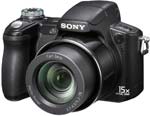
The Sony Cyber-shot DSC-H50 is a 9 megapixel digital camera equipped with a 15x Carl Zeiss lens, putting it squarely in the super-zoom category. Although not quite as wide-ranging as some of its 18x zoom competitors, the 31-465mm focal range of the DSC-H50 certainly covers a lot of bases, everything from landscape through to close-up wildlife photography. Sony's Super SteadyShot image stabilizer promises to keep things blur-free, whilst the macro mode allows you to focus on a subject just 1cm away. The large 3 inch LCD screen is of the tilting variety, allowing you to more easily frame shots from tricky angles, and the Sony DSC-H50 offers both a full range of manual exposure controls and more beginner friendly scene modes, including Intelligent Scene Recognition which automatically selects the correct shooting mode depending on the subject. With a recommended retail price of £299 / $399, the Sony Cyber-shot DSC-H50 is one of the cheaper super-zooms currently available, but can it compete with some pretty tough rivals? Gavin Stoker found out...
Compare Prices
Support PhotographyBLOG: Buy the Sony Cyber-shot DSC-H50 from one of our affiliate retailers:Ease of Use
Like its 'H' series predecessors, Sony's latest bridge camera in the 9.1 megapixel, 15x optical zoom Cyber-shot DSC-H50 is attempting to pull off the difficult trick of at once satisfying two distinct and typically separate groups: that of the mass market point-and-shoot brigade – who require operational simplicity as much as high image quality – plus photo enthusiasts, who want a bit more specification-wise to get their creative teeth into. Like most super zooms it purports to offer a 'best of both worlds' solution.
As you'd expect given the Sony branding, the H50 certainly feels built to an impressive standard, weighty in the palm (at 415g, body only) despite its plastic construction, with a large rounded grip that houses the rechargeable lithium ion battery and prominent lens barrel giving it that DSLR-like look and feel. Size wise, it's only a fraction smaller than Olympus' E-420 starter DSLR overall that we had for testing over the same period, and in fact the Sony is slightly wider in depth thanks to that aforementioned grip. Comparing it side by side with direct 'super zoom' rivals in Nikon's P80 (18x) and Fuji's S1000fd (12x), the H50 has almost identical control layout, dimensions and styling. For operation of the basic features, there's surprisingly little to choose between them in terms of ergonomics.
While Sony's H50 doesn't quite stretch to the 20x optical zoom range offered by the new Olympus SP-570UZ however, and its styling means the H50 is hardly a pocket model, Sony has many other alternatives if you're looking for a more fashion conscious device, plus, on the face of it, in the H50 you do get a generous amount of camera in return for your outlay – as well as features that the competition in its class hasn't yet matched. Chiefly this time around that includes a tilting and handily large 3-inch, 230k dot resolution LCD screen at the H50's rear that enables both tricky high and low angle shots. Unfortunately the mechanism is such that it can't be also rotated to the left or right but it's a certainly a boon for creative compositions. Seemingly covering all bases, there's also an electronic viewfinder immediately above, should visibility suffer in strong sunlight. While both are undoubtedly a drain on battery life, Sony claim a fully-charged cell will be good for up to 300 shots, though we found that slightly optimistic and battery power was showing a noticeable dip after half that amount.
Still, there is plenty of hand holding on offer for beginners, including intelligent scene recognition, the now ubiquitous face detection and Sony's extension of this concept in 'smile shutter'; the shooting mode selected via the top dial which automatically fires a shot when the camera detects your subject is a happy bunny. Given its broad focus range, equivalent to 31-465mm in 35mm film terms, the H50 boasts Sony's proprietary image stabilization in the form of Super SteadyShot. As usual there's the option to set the camera to adjust continuously to compensate for hand wobble and resultant image blur ('always on' mode), turn the feature off, or activate it only on an individual shot basis – kicking in when the shutter release button is pressed halfway.
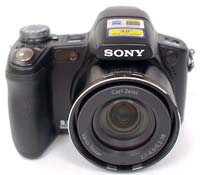 |
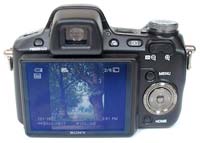 |
| Front | Rear |
Unlike previous generation H series Cyber-shot models, such as 2006's H2, there's sadly no dedicated button for activating Super SteadyShot on the fly. Instead you have to tab through the onscreen toolbar, initiated by pressing the menu button, to find and implement it. This seems a backwards step. Sony are going further however and claiming 'double anti blur technology' for the H50, meaning that you also get the ability to boost light sensitivity up to ISO 3200. Whether you'd want to risk that or not we'll come to later. Instead of a dedicated anti-shake button, top left of the H50's pop-up flash, there is however a dedicated slider for switching on its funky infrared nightshot mode, which captures everything in that tell-tale eerie green light beloved of low budget horror movie makers. Yes, this is a camera that can 'see in the dark'; a gimmick perhaps to most, but another extra not found among direct rivals. The results are inevitably better though the more available light there is.
Like Nikon's pro-end DSLRs, and some Sony snapshots, you also get HD output offered, though again you'll have to buy a compatible HDMI cable separately. Also, the maximum resolution of the video clips is still a standard definition 640x480 pixels, which seems a wasted opportunity, though MPEG1 video functionality does redeem itself to an extent by offering a respectable 30fps with (mono) sound. Of course, though compatibility is offered with Memory Stick Pro Duo cards, you'll have to supply your own one as well – a 2MB variety proved good for around 500+ JPEGs on test – though a measly 15MB internal cache is offered as back up. What you do get out of the box is a detachable lens cover as well as – unusually – a lens hood, to stamp out flare. Enthusiasts may however bemoan the lack of TIFF or RAW file formats – the latter offered by Olympus' SP-570UZ, along with that slightly broader range, though the Olympus falls down in the power stakes, offering AA compatibility only.
With our H50 introduction over then, let's pick the camera up and provide a tour of its features and functions. The front of the flagship H-series Cyber-shot is dominated by that humongous Carl Zeiss Vario-Tessar optically equipped lens, above which is a sloping hood that houses the bright and responsive pop-up flash when not in use. To the right is a remote sensor window to allow the camera to be operated in conjunction with the supplied remote control (another rarity in its class), beneath which are three pinpricks for the built in microphone, while to the left is a second window that acts as both the self-timer and smile shutter lamp. Left again is the forward slope of the camera's nicely rounded grip, complete with leather-effect padding that furthers the outward air of sophistication, with the shutter release button naturally sitting right at the front.
Moving to the top of the H50 then, we find the aforementioned nightshot switch, left of the rounded hump housing the flash, to the right of which is an almost identical lozenge shaped power on/off button. Both buttons, as goes for the H50's controls generally, are clearly labeled – there's no mistaking what these are for, and the layout feels user friendly too: there's nothing too small here, nothing too cramped or compromised for the sausage-fingered to take umbrage at. The H50 is reasonably quick to power up too, with a wait of a couple of seconds while the rear LCD flickers into the life and the zoom extends from within its barrel housing to maximum wide angle setting. To the right of the power switch is a familiar shooting mode dial with a professional-feel ridged edging and a firm action that provides just the right amount of give to quickly swap from one option to another in the heat of the action, without accidentally overshooting your choice.
 |
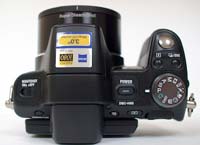 |
| Tilting LCD Screen | Top Controls |
For its average size, the H50's shooting dial feels uniquely crammed with features, with no fewer than 12 available settings. As well as the standard auto mode, you find the familiar PSAM creative controls, plus the aforementioned movie mode, a dedicated high sensitivity setting for when you haven't got time to manually adjust ISO via the rear screen menu, along with smile shutter, portrait, 'predictive' sports shooting mode, plus the usual smattering of pre-optimised scene modes. Turn the dial to this setting and users can additionally access landscape, two 'twilight' modes (one dedicated to portraits), plus beach, snow, and fireworks modes. Finally the last setting on the dial is marked 'easy' mode. Try pressing the menu button in this mode and the screen will merely allow the adjustment of image size or the switching of flash use from automatic to off. For granny the compositional screen meanwhile reveals number of shots remaining in nice big letters and a larger than usual battery life indicator.
Just forward and to the right of the mode dial is a useful dedicated button for quickly switching from single to continuous capture, or rattling off a sequence of three bracketed shots. To the left is a second identically sized button for switching metering mode between multi, centre or spot. In front of these is the previously mentioned shutter released button; the camera is rapid in determining focus and exposure with a clearly felt half press, while any shutter delay as you go on to take the shot is minimal. The H50 is similarly swift in committing a full resolution shot to memory: blink and you're ready to take the next, even in single capture mode.
The rear of the H50 is justifiably dominated by that large tilting LCD screen, which pivots upwards from storage flush to the back of the camera through 90°, and then further extends outwards and down through 160°, until you're looking up at the screen from below. Visibility is very good, and even in a reasonable amount of sunshine I didn't feel the need to switch to the small but still refreshingly detailed and clear 200k dot resolution EVF instead; the button for doing so located top left of the LCD, as still viewed from the back. Incidentally, pull the screen out as indicated and you'll find a built-in speaker hidden behind, while there's also an easily overlooked diopter adjustment dial to aid the short sighted lurking on the left of the eyepiece.
Top right of the LCD meanwhile is, unusually, a dedicated button for kick starting a slideshow complete with musical and visual effects – a funky feature more commonly found on Sony's Cyber-shot snapshot range than a bridge model in the H50's class. Fittingly, adjacent to this is a more standard playback button for review of individual or groups of images without musical accompaniment, for which there are, for the record, eight different audio choices to suit general musical taste. Right of this again is a rocker switch for activating the zoom, the operation of which is more steady than fast, but at least allows you to reasonably accurately stop at your intended framing. It's sound tracked by audible mechanics, but these aren't so loud as to be off-putting in any way – and even at maximum telephoto the image conveyed to the rear LCD is impressively steady.
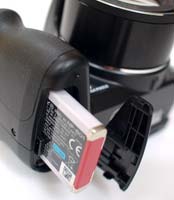 |
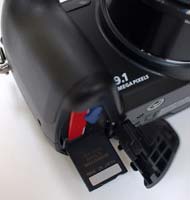 |
| Battery Compartment | Memory Card Slot |
Directly underneath this on the H50 is a self-explanatory 'menu' button. Press this and you're presented with a clean, user-friendly tool bar down the left hand side of the screen. Tab down using the four-way controller directly below and further sub-options are highlighted. You get to and activate these options – including noise reduction, colour filter and saturation options in anything but easy or full auto modes – by rubbing your thumb over the scroll wheel that surrounds the four way controller, or simply tabbing left or right. The selection of options using both the four way controller and surrounding wheel makes for slightly fiddly operation however; the control pad seems the more accurate option as it's easy to whiz past your desired setting using the wheel – which can be frustrating.
Ranged at four points around the control pad are a means of adjusting the on-screen display – including the ability to call up a live histogram – and, moving clockwise, select from available flash options, set the self timer, or manually select macro/close up mode. Confusingly, as well as a menu button, there's a further dedicated control near the base of the camera back marked 'home'. Described by the manual as a 'gateway' to all camera functions that can be called up regardless of whatever mode you're in, this is best viewed something of a 'housekeeping' control, as pressing it affords access to more general options including the ability to download music to the camera, earmark certain images for print, format the memory or adjust main settings, such as disabling the camera 'beep'.
I can't help thinking it would have been easier to group everything under 'menu' that you'd expect to find there on any other digital camera. As it stands, there were occasions where I couldn't find the option I wanted and found myself furiously tabbing between 'menu', 'display' and 'home' to track it down. To give one example, ISO settings aren't found within the main menus as expected – you have to tab around the screen and select small characters on the main display, and even then – as noted – responsiveness is such that it's easy to shoot past your chosen option. I can see in part Sony's reasons for splitting and dividing things up – to keep the individual menus and toolbars fairly clean and uncluttered – but it did seem to me to achieve the opposite of what it undoubtedly started off trying to do, and make for less fluid and certainly less intuitive operation.
Grumble over, we turn our attention to the right hand flank of the H50, if still viewed from the rear, which features a loop for attaching a shoulder strap, mirrored by a second loop on the opposite flank. Next to this is a rubber flap hiding a DC-in mains power port. Switching to the other side, we find another covered port for the supplied multi connector cable that itself features AV out and USB 2.0 connections. At the base of the H50 is located a screw thread for a tripod and a sliding cover protecting the joint battery and memory card (or rather Stick) compartment.
So everything present and correct here – along with a few we didn't expect – but what of the images themselves? Do they reveal a camera that shows off more than it delivers, or transcend any gimmicks to cut the proverbial mustard in every respect?
|
![]() PhotographyBLOG
is a member of the DIWA
organisation. Our test results for the Sony Cyber-shot DSC-H50 have been submitted to DIWA
for comparison with test results for different samples of
the same camera model supplied by other DIWA
member sites.
PhotographyBLOG
is a member of the DIWA
organisation. Our test results for the Sony Cyber-shot DSC-H50 have been submitted to DIWA
for comparison with test results for different samples of
the same camera model supplied by other DIWA
member sites.
